Comparison of Immersive and Spaced Learning Methods
VerifiedAdded on 2021/04/19
|8
|1963
|45
AI Summary
The assignment compares two educational methods: immersive learning and spaced learning. Immersive learning involves interactive experiences that allow learners to act and care about the outcome, while spaced learning focuses on remembering previously taught material. The document discusses how these methods differ in terms of game elements, teacher reactions, and technology usage. It also touches on the feasibility of using immersive virtual reality for music conducting skills and adaptive device context-based mobile learning systems.
Contribute Materials
Your contribution can guide someone’s learning journey. Share your
documents today.
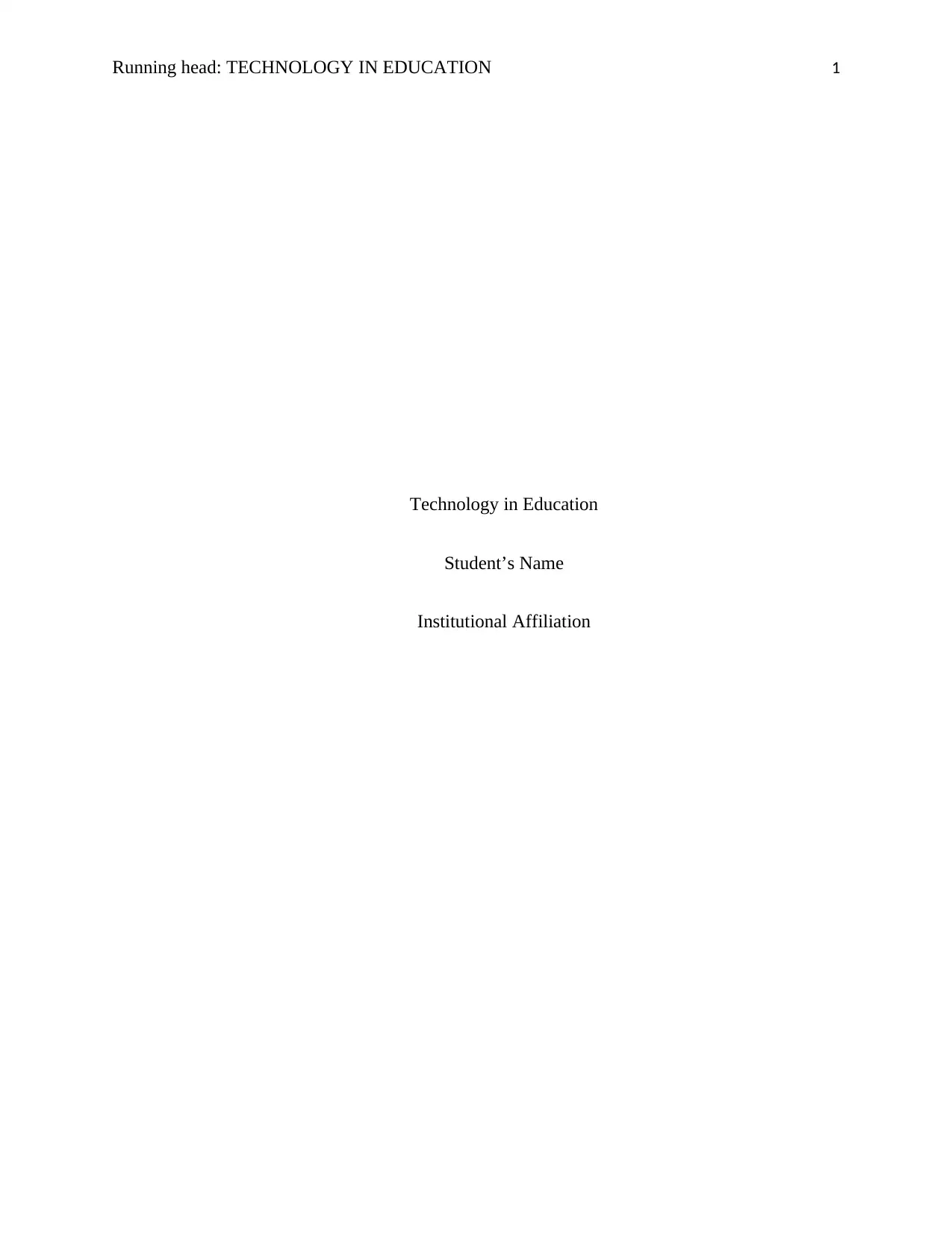
Running head: TECHNOLOGY IN EDUCATION 1
Technology in Education
Student’s Name
Institutional Affiliation
Technology in Education
Student’s Name
Institutional Affiliation
Secure Best Marks with AI Grader
Need help grading? Try our AI Grader for instant feedback on your assignments.
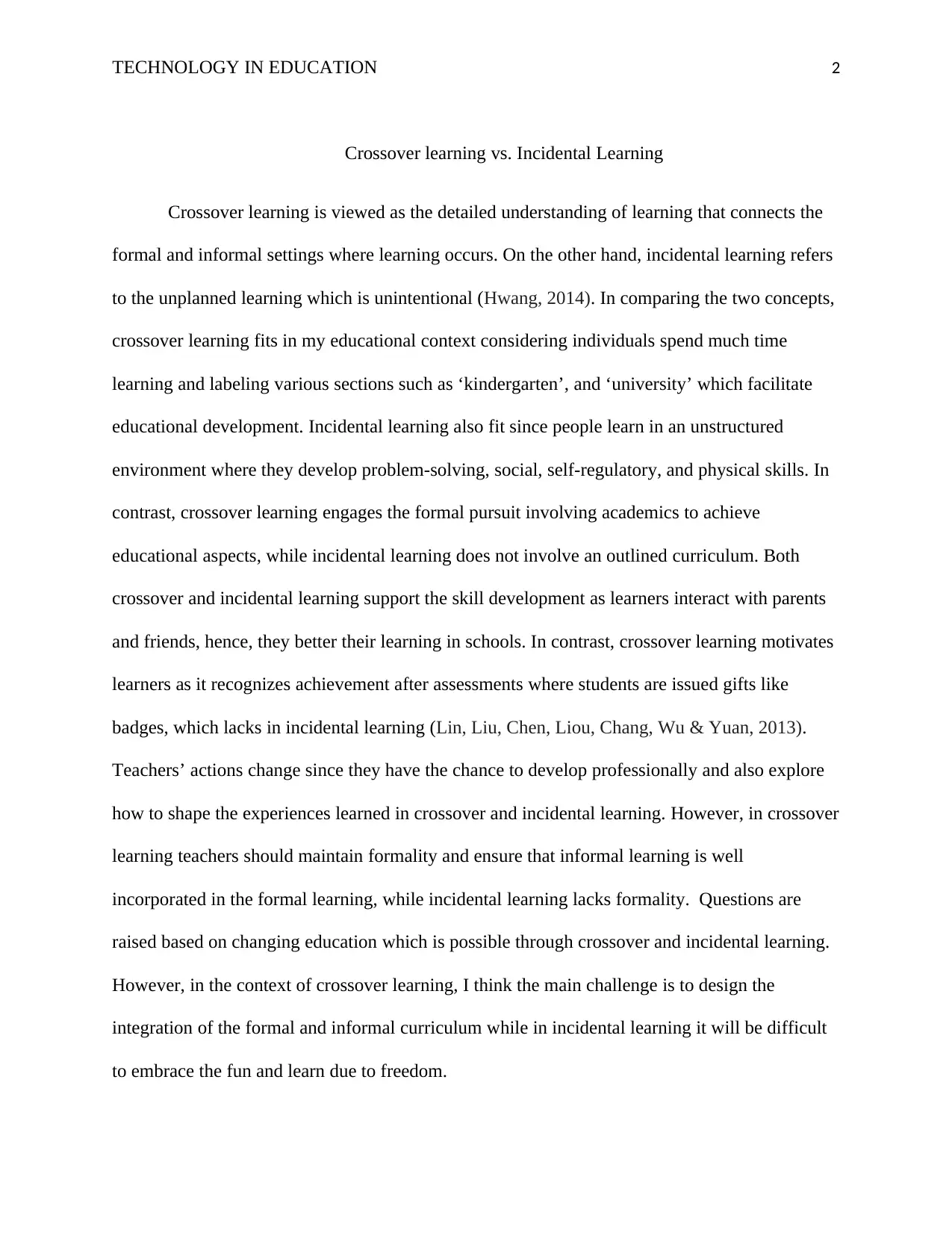
TECHNOLOGY IN EDUCATION 2
Crossover learning vs. Incidental Learning
Crossover learning is viewed as the detailed understanding of learning that connects the
formal and informal settings where learning occurs. On the other hand, incidental learning refers
to the unplanned learning which is unintentional (Hwang, 2014). In comparing the two concepts,
crossover learning fits in my educational context considering individuals spend much time
learning and labeling various sections such as ‘kindergarten’, and ‘university’ which facilitate
educational development. Incidental learning also fit since people learn in an unstructured
environment where they develop problem-solving, social, self-regulatory, and physical skills. In
contrast, crossover learning engages the formal pursuit involving academics to achieve
educational aspects, while incidental learning does not involve an outlined curriculum. Both
crossover and incidental learning support the skill development as learners interact with parents
and friends, hence, they better their learning in schools. In contrast, crossover learning motivates
learners as it recognizes achievement after assessments where students are issued gifts like
badges, which lacks in incidental learning (Lin, Liu, Chen, Liou, Chang, Wu & Yuan, 2013).
Teachers’ actions change since they have the chance to develop professionally and also explore
how to shape the experiences learned in crossover and incidental learning. However, in crossover
learning teachers should maintain formality and ensure that informal learning is well
incorporated in the formal learning, while incidental learning lacks formality. Questions are
raised based on changing education which is possible through crossover and incidental learning.
However, in the context of crossover learning, I think the main challenge is to design the
integration of the formal and informal curriculum while in incidental learning it will be difficult
to embrace the fun and learn due to freedom.
Crossover learning vs. Incidental Learning
Crossover learning is viewed as the detailed understanding of learning that connects the
formal and informal settings where learning occurs. On the other hand, incidental learning refers
to the unplanned learning which is unintentional (Hwang, 2014). In comparing the two concepts,
crossover learning fits in my educational context considering individuals spend much time
learning and labeling various sections such as ‘kindergarten’, and ‘university’ which facilitate
educational development. Incidental learning also fit since people learn in an unstructured
environment where they develop problem-solving, social, self-regulatory, and physical skills. In
contrast, crossover learning engages the formal pursuit involving academics to achieve
educational aspects, while incidental learning does not involve an outlined curriculum. Both
crossover and incidental learning support the skill development as learners interact with parents
and friends, hence, they better their learning in schools. In contrast, crossover learning motivates
learners as it recognizes achievement after assessments where students are issued gifts like
badges, which lacks in incidental learning (Lin, Liu, Chen, Liou, Chang, Wu & Yuan, 2013).
Teachers’ actions change since they have the chance to develop professionally and also explore
how to shape the experiences learned in crossover and incidental learning. However, in crossover
learning teachers should maintain formality and ensure that informal learning is well
incorporated in the formal learning, while incidental learning lacks formality. Questions are
raised based on changing education which is possible through crossover and incidental learning.
However, in the context of crossover learning, I think the main challenge is to design the
integration of the formal and informal curriculum while in incidental learning it will be difficult
to embrace the fun and learn due to freedom.
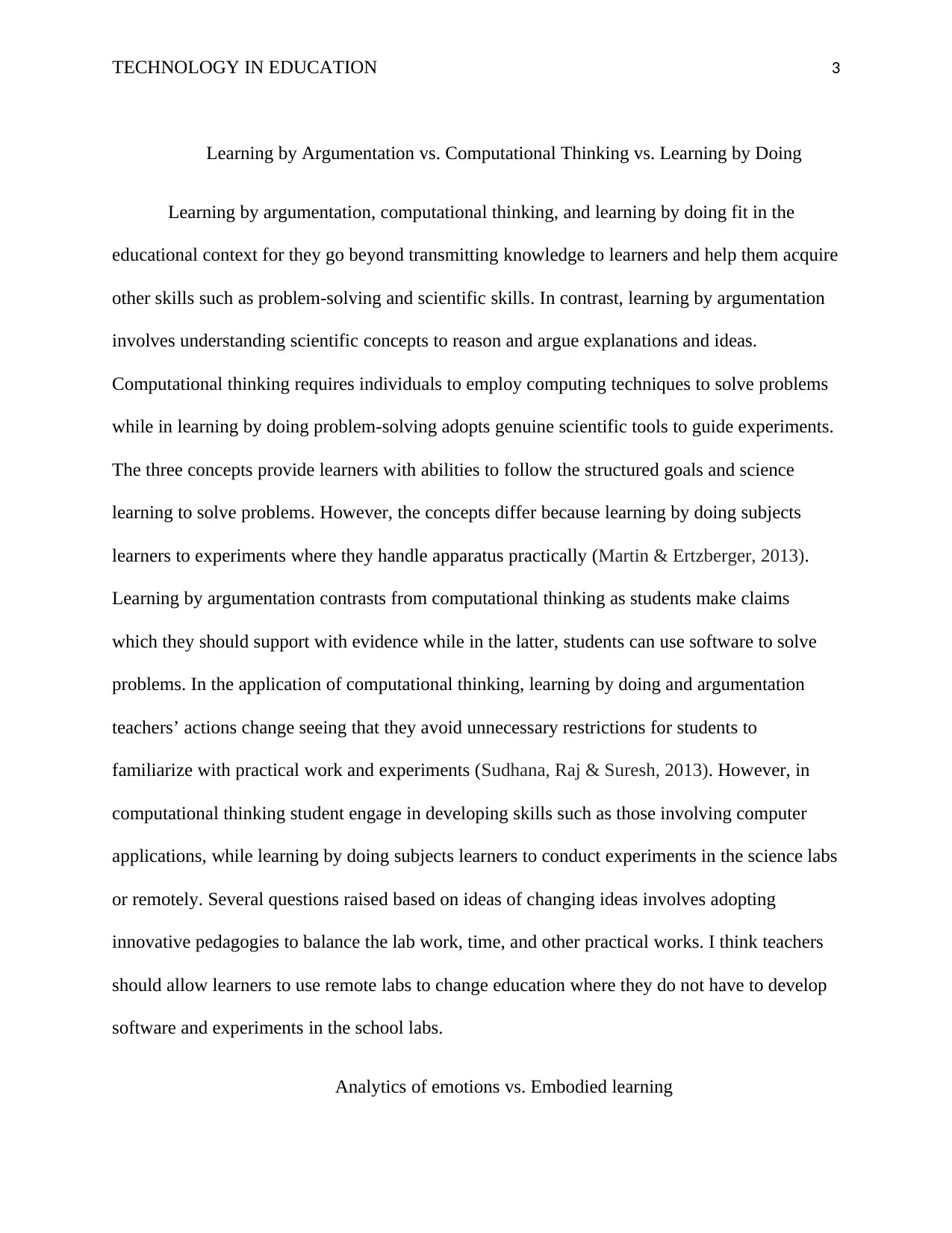
TECHNOLOGY IN EDUCATION 3
Learning by Argumentation vs. Computational Thinking vs. Learning by Doing
Learning by argumentation, computational thinking, and learning by doing fit in the
educational context for they go beyond transmitting knowledge to learners and help them acquire
other skills such as problem-solving and scientific skills. In contrast, learning by argumentation
involves understanding scientific concepts to reason and argue explanations and ideas.
Computational thinking requires individuals to employ computing techniques to solve problems
while in learning by doing problem-solving adopts genuine scientific tools to guide experiments.
The three concepts provide learners with abilities to follow the structured goals and science
learning to solve problems. However, the concepts differ because learning by doing subjects
learners to experiments where they handle apparatus practically (Martin & Ertzberger, 2013).
Learning by argumentation contrasts from computational thinking as students make claims
which they should support with evidence while in the latter, students can use software to solve
problems. In the application of computational thinking, learning by doing and argumentation
teachers’ actions change seeing that they avoid unnecessary restrictions for students to
familiarize with practical work and experiments (Sudhana, Raj & Suresh, 2013). However, in
computational thinking student engage in developing skills such as those involving computer
applications, while learning by doing subjects learners to conduct experiments in the science labs
or remotely. Several questions raised based on ideas of changing ideas involves adopting
innovative pedagogies to balance the lab work, time, and other practical works. I think teachers
should allow learners to use remote labs to change education where they do not have to develop
software and experiments in the school labs.
Analytics of emotions vs. Embodied learning
Learning by Argumentation vs. Computational Thinking vs. Learning by Doing
Learning by argumentation, computational thinking, and learning by doing fit in the
educational context for they go beyond transmitting knowledge to learners and help them acquire
other skills such as problem-solving and scientific skills. In contrast, learning by argumentation
involves understanding scientific concepts to reason and argue explanations and ideas.
Computational thinking requires individuals to employ computing techniques to solve problems
while in learning by doing problem-solving adopts genuine scientific tools to guide experiments.
The three concepts provide learners with abilities to follow the structured goals and science
learning to solve problems. However, the concepts differ because learning by doing subjects
learners to experiments where they handle apparatus practically (Martin & Ertzberger, 2013).
Learning by argumentation contrasts from computational thinking as students make claims
which they should support with evidence while in the latter, students can use software to solve
problems. In the application of computational thinking, learning by doing and argumentation
teachers’ actions change seeing that they avoid unnecessary restrictions for students to
familiarize with practical work and experiments (Sudhana, Raj & Suresh, 2013). However, in
computational thinking student engage in developing skills such as those involving computer
applications, while learning by doing subjects learners to conduct experiments in the science labs
or remotely. Several questions raised based on ideas of changing ideas involves adopting
innovative pedagogies to balance the lab work, time, and other practical works. I think teachers
should allow learners to use remote labs to change education where they do not have to develop
software and experiments in the school labs.
Analytics of emotions vs. Embodied learning
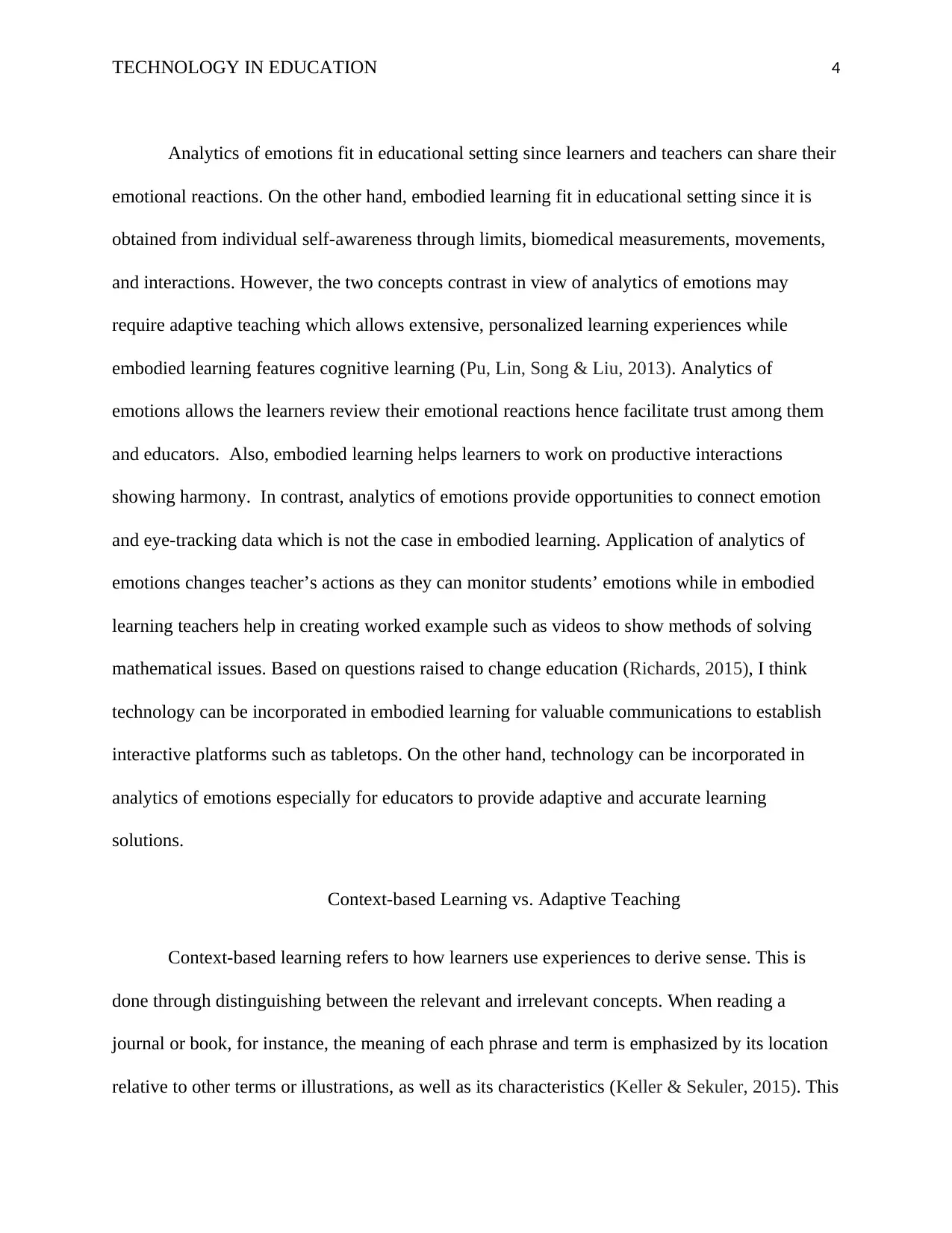
TECHNOLOGY IN EDUCATION 4
Analytics of emotions fit in educational setting since learners and teachers can share their
emotional reactions. On the other hand, embodied learning fit in educational setting since it is
obtained from individual self-awareness through limits, biomedical measurements, movements,
and interactions. However, the two concepts contrast in view of analytics of emotions may
require adaptive teaching which allows extensive, personalized learning experiences while
embodied learning features cognitive learning (Pu, Lin, Song & Liu, 2013). Analytics of
emotions allows the learners review their emotional reactions hence facilitate trust among them
and educators. Also, embodied learning helps learners to work on productive interactions
showing harmony. In contrast, analytics of emotions provide opportunities to connect emotion
and eye-tracking data which is not the case in embodied learning. Application of analytics of
emotions changes teacher’s actions as they can monitor students’ emotions while in embodied
learning teachers help in creating worked example such as videos to show methods of solving
mathematical issues. Based on questions raised to change education (Richards, 2015), I think
technology can be incorporated in embodied learning for valuable communications to establish
interactive platforms such as tabletops. On the other hand, technology can be incorporated in
analytics of emotions especially for educators to provide adaptive and accurate learning
solutions.
Context-based Learning vs. Adaptive Teaching
Context-based learning refers to how learners use experiences to derive sense. This is
done through distinguishing between the relevant and irrelevant concepts. When reading a
journal or book, for instance, the meaning of each phrase and term is emphasized by its location
relative to other terms or illustrations, as well as its characteristics (Keller & Sekuler, 2015). This
Analytics of emotions fit in educational setting since learners and teachers can share their
emotional reactions. On the other hand, embodied learning fit in educational setting since it is
obtained from individual self-awareness through limits, biomedical measurements, movements,
and interactions. However, the two concepts contrast in view of analytics of emotions may
require adaptive teaching which allows extensive, personalized learning experiences while
embodied learning features cognitive learning (Pu, Lin, Song & Liu, 2013). Analytics of
emotions allows the learners review their emotional reactions hence facilitate trust among them
and educators. Also, embodied learning helps learners to work on productive interactions
showing harmony. In contrast, analytics of emotions provide opportunities to connect emotion
and eye-tracking data which is not the case in embodied learning. Application of analytics of
emotions changes teacher’s actions as they can monitor students’ emotions while in embodied
learning teachers help in creating worked example such as videos to show methods of solving
mathematical issues. Based on questions raised to change education (Richards, 2015), I think
technology can be incorporated in embodied learning for valuable communications to establish
interactive platforms such as tabletops. On the other hand, technology can be incorporated in
analytics of emotions especially for educators to provide adaptive and accurate learning
solutions.
Context-based Learning vs. Adaptive Teaching
Context-based learning refers to how learners use experiences to derive sense. This is
done through distinguishing between the relevant and irrelevant concepts. When reading a
journal or book, for instance, the meaning of each phrase and term is emphasized by its location
relative to other terms or illustrations, as well as its characteristics (Keller & Sekuler, 2015). This
Secure Best Marks with AI Grader
Need help grading? Try our AI Grader for instant feedback on your assignments.
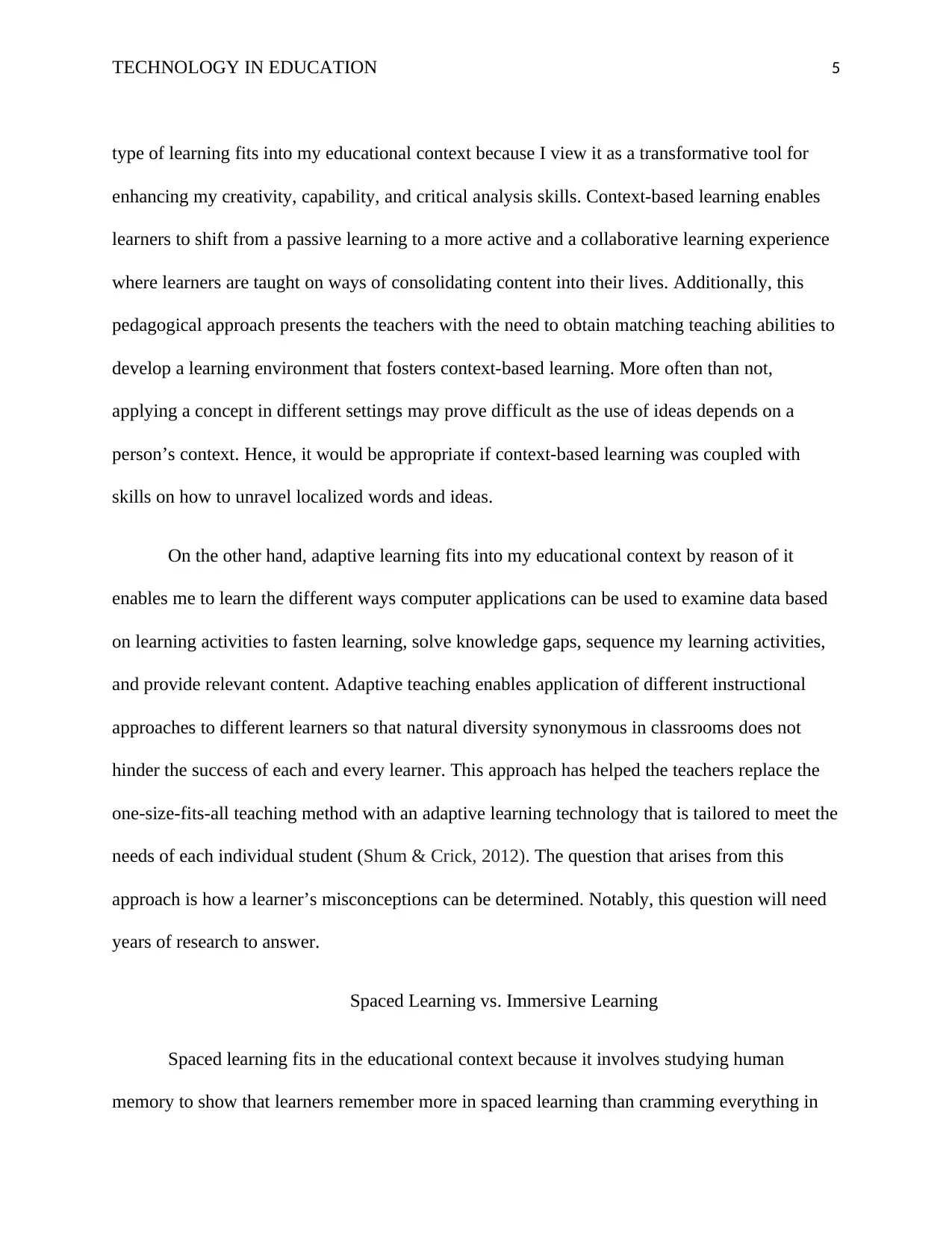
TECHNOLOGY IN EDUCATION 5
type of learning fits into my educational context because I view it as a transformative tool for
enhancing my creativity, capability, and critical analysis skills. Context-based learning enables
learners to shift from a passive learning to a more active and a collaborative learning experience
where learners are taught on ways of consolidating content into their lives. Additionally, this
pedagogical approach presents the teachers with the need to obtain matching teaching abilities to
develop a learning environment that fosters context-based learning. More often than not,
applying a concept in different settings may prove difficult as the use of ideas depends on a
person’s context. Hence, it would be appropriate if context-based learning was coupled with
skills on how to unravel localized words and ideas.
On the other hand, adaptive learning fits into my educational context by reason of it
enables me to learn the different ways computer applications can be used to examine data based
on learning activities to fasten learning, solve knowledge gaps, sequence my learning activities,
and provide relevant content. Adaptive teaching enables application of different instructional
approaches to different learners so that natural diversity synonymous in classrooms does not
hinder the success of each and every learner. This approach has helped the teachers replace the
one-size-fits-all teaching method with an adaptive learning technology that is tailored to meet the
needs of each individual student (Shum & Crick, 2012). The question that arises from this
approach is how a learner’s misconceptions can be determined. Notably, this question will need
years of research to answer.
Spaced Learning vs. Immersive Learning
Spaced learning fits in the educational context because it involves studying human
memory to show that learners remember more in spaced learning than cramming everything in
type of learning fits into my educational context because I view it as a transformative tool for
enhancing my creativity, capability, and critical analysis skills. Context-based learning enables
learners to shift from a passive learning to a more active and a collaborative learning experience
where learners are taught on ways of consolidating content into their lives. Additionally, this
pedagogical approach presents the teachers with the need to obtain matching teaching abilities to
develop a learning environment that fosters context-based learning. More often than not,
applying a concept in different settings may prove difficult as the use of ideas depends on a
person’s context. Hence, it would be appropriate if context-based learning was coupled with
skills on how to unravel localized words and ideas.
On the other hand, adaptive learning fits into my educational context by reason of it
enables me to learn the different ways computer applications can be used to examine data based
on learning activities to fasten learning, solve knowledge gaps, sequence my learning activities,
and provide relevant content. Adaptive teaching enables application of different instructional
approaches to different learners so that natural diversity synonymous in classrooms does not
hinder the success of each and every learner. This approach has helped the teachers replace the
one-size-fits-all teaching method with an adaptive learning technology that is tailored to meet the
needs of each individual student (Shum & Crick, 2012). The question that arises from this
approach is how a learner’s misconceptions can be determined. Notably, this question will need
years of research to answer.
Spaced Learning vs. Immersive Learning
Spaced learning fits in the educational context because it involves studying human
memory to show that learners remember more in spaced learning than cramming everything in
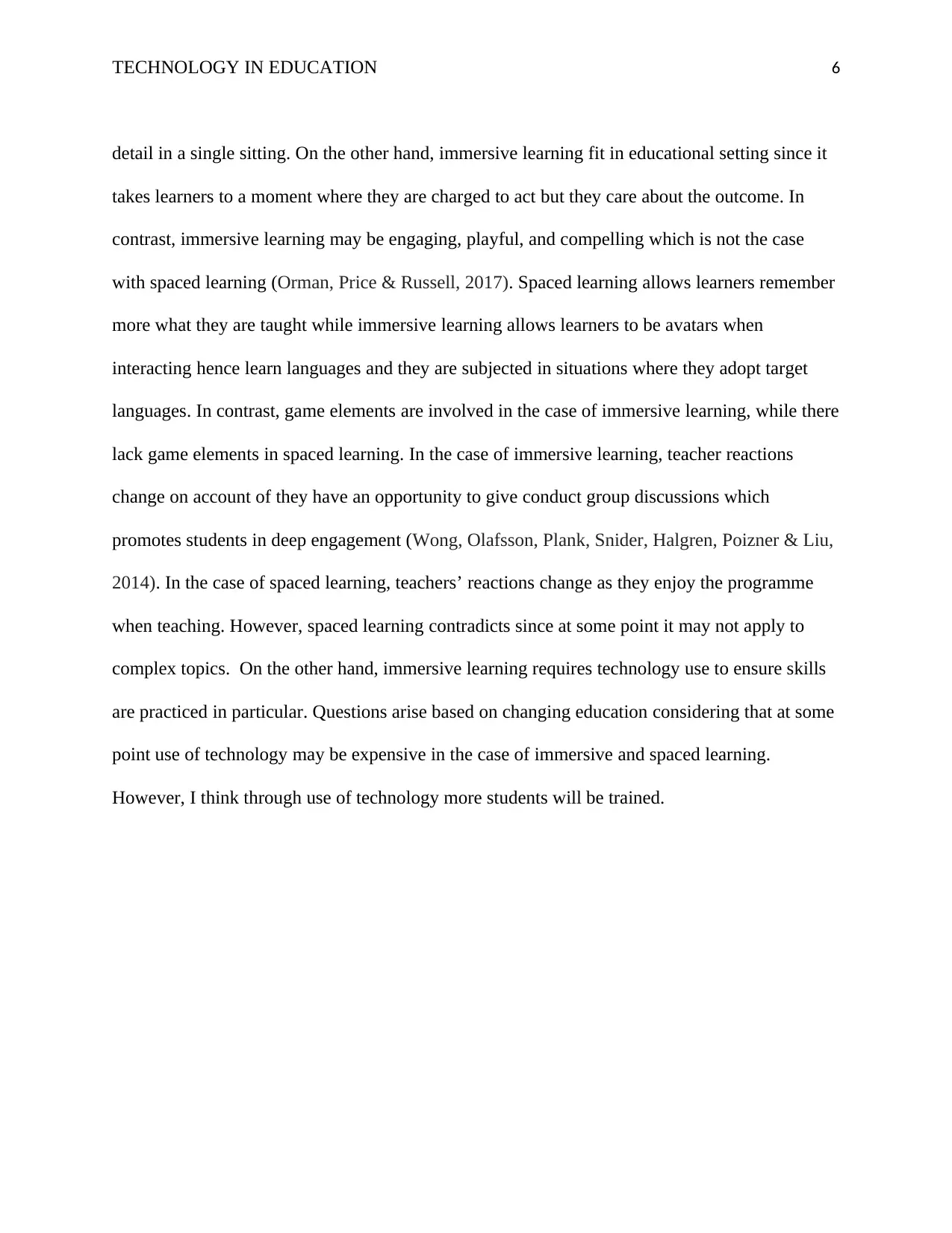
TECHNOLOGY IN EDUCATION 6
detail in a single sitting. On the other hand, immersive learning fit in educational setting since it
takes learners to a moment where they are charged to act but they care about the outcome. In
contrast, immersive learning may be engaging, playful, and compelling which is not the case
with spaced learning (Orman, Price & Russell, 2017). Spaced learning allows learners remember
more what they are taught while immersive learning allows learners to be avatars when
interacting hence learn languages and they are subjected in situations where they adopt target
languages. In contrast, game elements are involved in the case of immersive learning, while there
lack game elements in spaced learning. In the case of immersive learning, teacher reactions
change on account of they have an opportunity to give conduct group discussions which
promotes students in deep engagement (Wong, Olafsson, Plank, Snider, Halgren, Poizner & Liu,
2014). In the case of spaced learning, teachers’ reactions change as they enjoy the programme
when teaching. However, spaced learning contradicts since at some point it may not apply to
complex topics. On the other hand, immersive learning requires technology use to ensure skills
are practiced in particular. Questions arise based on changing education considering that at some
point use of technology may be expensive in the case of immersive and spaced learning.
However, I think through use of technology more students will be trained.
detail in a single sitting. On the other hand, immersive learning fit in educational setting since it
takes learners to a moment where they are charged to act but they care about the outcome. In
contrast, immersive learning may be engaging, playful, and compelling which is not the case
with spaced learning (Orman, Price & Russell, 2017). Spaced learning allows learners remember
more what they are taught while immersive learning allows learners to be avatars when
interacting hence learn languages and they are subjected in situations where they adopt target
languages. In contrast, game elements are involved in the case of immersive learning, while there
lack game elements in spaced learning. In the case of immersive learning, teacher reactions
change on account of they have an opportunity to give conduct group discussions which
promotes students in deep engagement (Wong, Olafsson, Plank, Snider, Halgren, Poizner & Liu,
2014). In the case of spaced learning, teachers’ reactions change as they enjoy the programme
when teaching. However, spaced learning contradicts since at some point it may not apply to
complex topics. On the other hand, immersive learning requires technology use to ensure skills
are practiced in particular. Questions arise based on changing education considering that at some
point use of technology may be expensive in the case of immersive and spaced learning.
However, I think through use of technology more students will be trained.
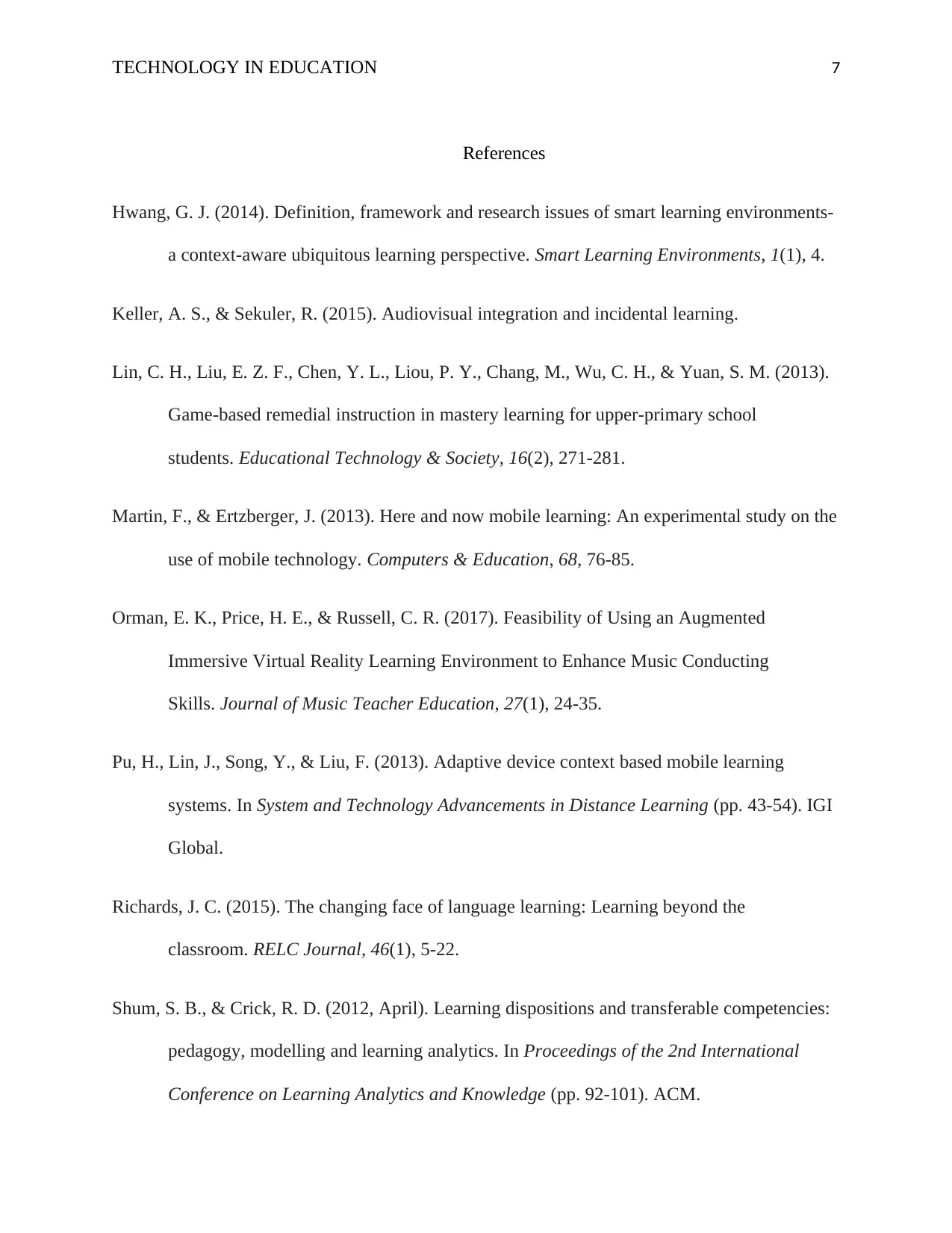
TECHNOLOGY IN EDUCATION 7
References
Hwang, G. J. (2014). Definition, framework and research issues of smart learning environments-
a context-aware ubiquitous learning perspective. Smart Learning Environments, 1(1), 4.
Keller, A. S., & Sekuler, R. (2015). Audiovisual integration and incidental learning.
Lin, C. H., Liu, E. Z. F., Chen, Y. L., Liou, P. Y., Chang, M., Wu, C. H., & Yuan, S. M. (2013).
Game-based remedial instruction in mastery learning for upper-primary school
students. Educational Technology & Society, 16(2), 271-281.
Martin, F., & Ertzberger, J. (2013). Here and now mobile learning: An experimental study on the
use of mobile technology. Computers & Education, 68, 76-85.
Orman, E. K., Price, H. E., & Russell, C. R. (2017). Feasibility of Using an Augmented
Immersive Virtual Reality Learning Environment to Enhance Music Conducting
Skills. Journal of Music Teacher Education, 27(1), 24-35.
Pu, H., Lin, J., Song, Y., & Liu, F. (2013). Adaptive device context based mobile learning
systems. In System and Technology Advancements in Distance Learning (pp. 43-54). IGI
Global.
Richards, J. C. (2015). The changing face of language learning: Learning beyond the
classroom. RELC Journal, 46(1), 5-22.
Shum, S. B., & Crick, R. D. (2012, April). Learning dispositions and transferable competencies:
pedagogy, modelling and learning analytics. In Proceedings of the 2nd International
Conference on Learning Analytics and Knowledge (pp. 92-101). ACM.
References
Hwang, G. J. (2014). Definition, framework and research issues of smart learning environments-
a context-aware ubiquitous learning perspective. Smart Learning Environments, 1(1), 4.
Keller, A. S., & Sekuler, R. (2015). Audiovisual integration and incidental learning.
Lin, C. H., Liu, E. Z. F., Chen, Y. L., Liou, P. Y., Chang, M., Wu, C. H., & Yuan, S. M. (2013).
Game-based remedial instruction in mastery learning for upper-primary school
students. Educational Technology & Society, 16(2), 271-281.
Martin, F., & Ertzberger, J. (2013). Here and now mobile learning: An experimental study on the
use of mobile technology. Computers & Education, 68, 76-85.
Orman, E. K., Price, H. E., & Russell, C. R. (2017). Feasibility of Using an Augmented
Immersive Virtual Reality Learning Environment to Enhance Music Conducting
Skills. Journal of Music Teacher Education, 27(1), 24-35.
Pu, H., Lin, J., Song, Y., & Liu, F. (2013). Adaptive device context based mobile learning
systems. In System and Technology Advancements in Distance Learning (pp. 43-54). IGI
Global.
Richards, J. C. (2015). The changing face of language learning: Learning beyond the
classroom. RELC Journal, 46(1), 5-22.
Shum, S. B., & Crick, R. D. (2012, April). Learning dispositions and transferable competencies:
pedagogy, modelling and learning analytics. In Proceedings of the 2nd International
Conference on Learning Analytics and Knowledge (pp. 92-101). ACM.
Paraphrase This Document
Need a fresh take? Get an instant paraphrase of this document with our AI Paraphraser
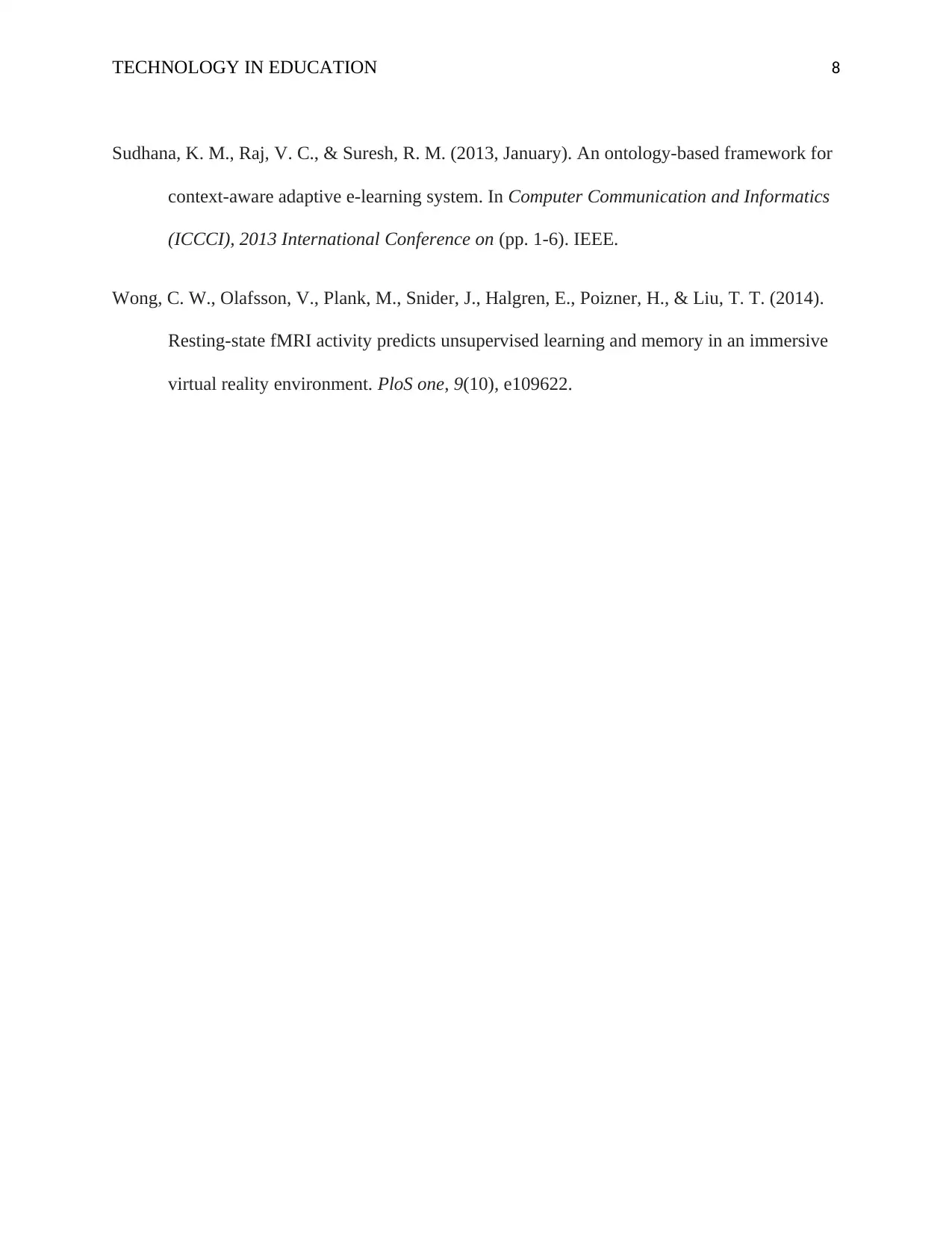
TECHNOLOGY IN EDUCATION 8
Sudhana, K. M., Raj, V. C., & Suresh, R. M. (2013, January). An ontology-based framework for
context-aware adaptive e-learning system. In Computer Communication and Informatics
(ICCCI), 2013 International Conference on (pp. 1-6). IEEE.
Wong, C. W., Olafsson, V., Plank, M., Snider, J., Halgren, E., Poizner, H., & Liu, T. T. (2014).
Resting-state fMRI activity predicts unsupervised learning and memory in an immersive
virtual reality environment. PloS one, 9(10), e109622.
Sudhana, K. M., Raj, V. C., & Suresh, R. M. (2013, January). An ontology-based framework for
context-aware adaptive e-learning system. In Computer Communication and Informatics
(ICCCI), 2013 International Conference on (pp. 1-6). IEEE.
Wong, C. W., Olafsson, V., Plank, M., Snider, J., Halgren, E., Poizner, H., & Liu, T. T. (2014).
Resting-state fMRI activity predicts unsupervised learning and memory in an immersive
virtual reality environment. PloS one, 9(10), e109622.
1 out of 8
Related Documents
Your All-in-One AI-Powered Toolkit for Academic Success.
+13062052269
info@desklib.com
Available 24*7 on WhatsApp / Email
![[object Object]](/_next/static/media/star-bottom.7253800d.svg)
Unlock your academic potential
© 2024 | Zucol Services PVT LTD | All rights reserved.





